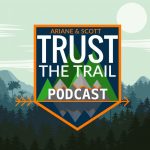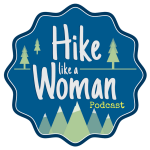
Overview
With the right preparation, the 100 Mile Wilderness (100MW) can be a challenging but enjoyable eight-day hike (and for thru-hikers and experienced “speedhikers,” who can rip off 20-mile days, substantially less). Dad (then 41) and daughter (then 12) completed this in two segments in 2017 and 2018. We definitely allowed ourselves extra time to enjoy places we liked, or to recover from wet gear or injuries, so plan on ten days. Our 100 Mile Wilderness journey finally complete, we took a look back and came up with a better plan of attack. So, here is our guide, with a suggested itinerary, and a packing list.
Direction: There are arguments for going south to north (like we did), or alternately, starting at Abol Bridge, and finishing in Monson. The northern part is substantially flatter (read: faster) terrain, so starting with a heavy pack might be easier north-south, eating up food weight as you move south. But starting from the south, and climbing over the Barren-Chairback and White Cap ranges might make your tired legs want to finish with the more gently rolling terrain of the north.
Timing: When we started the 100 MW, we did so at the end of June/beginning of July. Once we got down from the higher elevations, the heat was oppressive, and the bugs were brutal. We later finished the 100 MW at the end of September, and it was cold at night, but pleasant during the day, and there were no bugs. I think a happy medium would be the beginning of September (assuming your work/school/life allows this), which would still be warm enough to enjoy dips in the lakes and streams, cool enough at night to sleep well, and at the very tail end of bug season. One caveat to this plan – AT Lean-To’s and tent sites may be fairly full, as many thru-hikers will be making their last push to Katahdin. Check out this summary from The Trek of thru-hiker tips for the 100MW, including a 5-day itinerary. Some water sources may also be dry by this time of summer, depending on the rains. Speaking of which, watch the weather forecast – water crossings can be treacherous after heavy rains further upstream.
Resupply: We didn’t do this, but it’s worth considering. Some purists believe that it’s cheating, but lightening your pack enough to enjoy your walk in the woods might help a great deal, and it’s your hike. Shaw’s Hiker Hostel (Monson), the Appalachian Trail Lodge (Millinocket), and 100 Mile Wilderness Adventures and Outfitters are reputable providers who can coordinate food drops for you along the 100MW. They can also provide advice, shuttle service, Baxter/Katahdin permits, help you stage your vehicle at either end, and provide a place to stay before and/or after.

Suggested Itinerary
Day 1: ME-15 in Monson to Wilson Valley Lean-To (10.4 mi)
Overview: Day One is a rolling hike, getting used to a heavy pack, and fording several streams.
Highlight: Little Wilson Falls, a sixty-foot waterfall (mile 6.6)
Day 2: Wilson Valley Lean-To to West Chairback Pond (14.1 mi)
Overview: Day Two is a longer day (start early), with a ford of Long Pond Stream, and a a steady, strenuous ascent of Barren Mountain, to an up-and-down traverse of the Barren-Chairback Range, ending with a tent site on West Chairback Pond (.2 mile side trail).
Highlight: Views from Barren Ledges (mile 6) and insectivorous pitcher plants in Fourth Mountain Bog (mile 10.4).
Day 3: West Chairback Pond to Carl A. Newhall Lean-To (11.8 mi)
Overview: Completion of Barren-Chairback traverse, and descent to the fording of the West Branch of the Pleasant River. The afternoon ascent up Gulf Hagas Mountain along Gulf Hagas Brook will feel long, without many landmarks (note: camping or campfires are prohibited south of the Gulf Hagas Cut-off trail to north of the West Branch of the Pleasant River).
Highlight: Dizzying descent of Chairback Mountain, and a welcome downhill hike through pine forests to Gulf Hagas and the tall old-growth pines of the Hermitage.
Change-up: AMC Gorman Chairback Lodge and Cabins, on Long Pond, accessible via Third Mountain Trail or K-I Road. This AMC Lodge is a place to rest, get clean, relax, and enjoy the wilderness.
Day 4: Carl A. Newhall Lean-To to East Branch Lean-To (10.8 mi)
Overview: A long ascent of the White Cap range, then a descent to the East Branch of the Pleasant River.
Highlight: Cold, clear spring water from the spring near the Sidney Tappan Campsite (source of Gulf Hagas Brook). Summit of White Cap (3,654 ft), with great views (on a clear day) that include Katahdin.
Day 5: East Branch Lean-To to Antlers Campsite (16 mi)
Overview: A climb over the saddle between Big and Little Boardman Mountains, over Little Boardman, a long walk past Crawford Pond and Cooper Pond (watch for moose) to Antlers Campsite on Lower Jo-Mary Lake.
Highlight: Swimming in Crawford Pond (5.1 mi)
Day 6: Antlers Campsite to South End, Nahmakanta Lake (11 mi)
Overview: Short climb over Potaywadjo Ridge, pass Pemadumcook Lake, walk along Nahmakanta Stream to south end of Nahmakanta Lake.
Highlight: Swimming at sand beach on Lower Jo-Mary Lake (1.7 mi), and Lake Nahmakanta (11 mi).
Change-up: for a break and a hot meal, try White House Landing Camps on Pemadumcook Lake (look for the sign along the AT), who will pick you up by boat if you call, (207) 745-5116, and meet them at a landing off the old Mahar Tote Road (appx 5.1 mi south of Nahmakanta Lake). There is a great 2018 podcast episode on how White House Landing Camps came to be: http://www.outtherepodcast.com/episodes/2018/11/24/perfect-strangers
Day 7: South End, Nahmakanta Lake to Rainbow Stream Lean-To (10.7 mi)
Overview: One last mountain to cross, Nesuntabunt, then a long, forested walk to Rainbow Stream Lean-To.
Highlight: Swimming holes near Rainbow Stream Lean-To (10.7 mi).
Day 8: Rainbow Stream Lean-To to Abol Bridge (15 mi)
Overview: Last day, peaceful walk alongside Rainbow Deadwaters and Rainbow Lake, a short ascent and descent of Rainbow Ledges, and a last push across rolling forest and bog to Abol Bridge.
Highlight: View from Rainbow Ledges (9 mi), and finishing.

Packing List
We will assume that, if you are hiking the 100 MW, you have already chosen your pack and boots, know if you want hiking poles (yes, please, especially on wet, rocky descents), and know how you will cook and purify water. We overpacked, and this list (with links to what we used) cuts out non-essentials like a mini-fishing rod (we didn’t catch anything), and firestarter sticks (we only made two fires – in designated areas, of course, and birch bark worked nicely). Dad had a 75-liter, sixty lb pack because he didn’t want to come up short on supplies with a kid in the woods, but this can be done with a much lighter pack. Remember to leave no trace (empty meal pouches make great trash bags to carry with you). Also, waterproof Stuff Sacks are essential to streamline your packing, keep items dry, and double as bear bags to suspend your food at night. Would recommend at least two (one each for clothing and food).
Exterior:
Pack raincover (budget alternative is a trash bag) Osprey UltraLight Raincover
Osprey Hydraulics 3L water reservoir (this can be heavy, but you don’t have to fill it all the way. You may also prefer 2 smaller liter-size bottles with purification tablets, instead)
MSR Sweetwater Microfilter for water purification (see above)
Camping/hygiene gear:
Headlamp/batteries
Solar lantern (lightweight, collapsible, and lights up interior of tent at night)
Tent and ground cloth (we used Kelty Salida 2 two-person, with ground cloth). Some try to cut weight by just using a sleeping bag and pad, and using the AT shelters, but we found that they were crowded and noisy, and the tent gave us the option of finding a beautiful spot early, or pushing a little further, and just finding a flat spot at night.
Lightweight sleeping bag (we both used Marmot NanoWave 55, which was perfect)
Sleeping pad (Therm-a-rest ProLite Mattress was compact and comfortable)
Wicking towel (Packtowl UltraLite Towel wrapped around clothing doubled as pillow)
Mosquito headnet (get a long one that you can tuck into your shirt)
Parachute Cord (this is great, with StuffSacks, for hanging food up at night, making repairs, and attaching things to your pack)
Baby wipes
Raingear (your choice, would suggest high-quality lightweight jacket and pants, rather than poncho)
Maps (we used Maps 1 through 3 of the Official Map and Guide to the AT in Maine)
Compass
Ivory soap in Ziploc (99.44% pure, and it floats. Perfect for cleaning up in lakes/streams)
Gold Bond foot powder
Toothbrush
Toothpaste
Sunblock
Bug spray w/Deet
Toilet paper
First Aid kit: tweezers, bandaids, moleskin, itch cream, ibuprofen
Folding knife
Duct tape (mini-roll)
USB solar charger (updated 2024, based on reviews and increases in tech – this is pretty neat, lightweight, and recharges while you hike, using the sun. Great way to keep juice in your phone for photos or proof-of-life text messages when cell service is available)
Eating (mesh bag for cookware) :
- All-in-one spork (Light My Fire Titanium Spork)
- JetBoil stove with igniter and two fuel containers (plus back-up lighter)
- SeatoSummit collapsible bowl (we shared entrees, you don’t need this solo)
- Aluminum mug for coffee/hot chocolate/adult beverages
- Sponge soaked in soap (in Ziploc to clean up), and small rag to dry
Clothing (this will vary based on timing- this was our mid-summer list):
3 + pairs wool socks (Smartwool Med. Weight Hiker)
2 pairs Ex Officio underwear (quick-drying, anti-microbial)
2 t-shirts/tank tops
2 pairs convertible pants/shorts
Hat
Clean long-sleeve t-shirt/shorts in Ziploc (to wear at night/in camp)
Lightweight shoes (I can’t wear Crocs, but people love them. Flip flops are no good for river crossings. Happy medium may be barefoot trailrunning shoes)
1 jacket or heavy shirt
Food (plan on 1.5 to 2 lbs per person per day, and realize you will be sick of most of it by Day 3, so variety is good. Get rid of bulky packaging before you hike, and in the morning, take out the food for each day, placing it in more accessible pouches on the outside of your pack):
- Mountain House freeze-dried meals or packaged (Annie’s) mac and cheese (dinner)
- Pepperoni
- Cheese sticks
- Tortillas/lavash bread (use with pepperoni and cheese sticks to roll up)
- Oatmeal (breakfast)
- Peanut butter and/or Nutella
- Mixed Nuts (mix in with oatmeal, also mixes with dark chocolate are great)
- Pre-made PB +J sandwiches
- Granola/Energy bars (rotate flavors)
- Chocolate
- Beef jerky
- Starbucks Via instant coffee and/or hot chocolate packets
Final Thoughts
There will always be better ideas, lighter gear, more efficient plans. These are simply lessons we learned, and feedback is appreciated. The itinerary above is intended as a guideline, but there are side trails aplenty, and if you look at our journey, we adjusted to slow down and dry out our gear, avoid lightning and dangerous river fords, and speeded up to push ahead on better days.
If you are taking on the 100 Mile Wilderness, train to do so beforehand, hiking over rough terrain with a heavy pack, and doing multi-day hikes, breaking in all your gear, and finding out where your hot spots/blisters/chafe marks accumulate. There is no gym replacement or substitute for this. Our train-up was a fun couple months in the woods of Maine and New Hampshire, increasing distances and pack loads the entire time.
Additionally, have an exit strategy for the 100 Mile Wilderness. You may sustain an injury or find yourself in a situation beyond your control – that’s why it’s a wilderness, and this is a challenge. Be realistic, and don’t let pride goad you into bad decisions. But above all, have fun, and get outside.
(Disclaimer: This post contains affiliate links, and as an Amazon Associate Hiking in Maine blog earns from qualifying purchases.)













 Hike Like A Woman
Hike Like A Woman